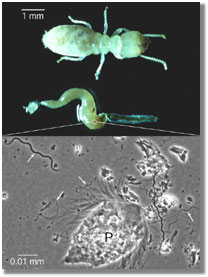 |
|
|
 |
||
| ||||||||||||||||||||||
|
Microbiologists Find a New Source of Nitrogen Fixation
|
||||||||||||||||||||||
|
|
|
Microbiologists have discovered that a type of bacteria found in termite guts and in fresh and salt water plays a major role in the process of nitrogen fixation. All organisms require the element to survive.
In the June 29 issue of the journal Science, a team led by National Science Foundation (NSF)-funded microbiologist John Breznak of Michigan State University (MSU) reports that spirochetes - spiral and wavy-shaped bacteria - are important providers of nitrogen in termites, whose ability to thrive despite a nitrogen-poor diet of plant matter had posed a decades-old puzzle.
Although nitrogen gas makes up 80 percent of the air we breathe, only certain microbes can capture and use it for growth - a process called nitrogen fixation. Once nitrogen gas becomes "fixed" by microbes, it enters the food chain and is ultimately used by plants and animals.
Breznak began studying the symbiosis between termites and their gut microbes almost 30 years ago, when he discovered that bacterial nitrogen fixation occurs within termites and could furnish up to 60 percent of the insects' nitrogen needs. But the particular microbes performing that fixation had been unclear. With colleagues at MSU and the California Institute of Technology, Breznak made an important breakthrough in 1999 by isolating spirochetes from termite guts and growing them in test tubes where they can now be examined in detail.
"The spirochetes not only contained the genes for nitrogen fixation," Breznak said, "they performed nitrogen fixation at rates consistent with those seen in living termites. This was very exciting, because nitrogen fixation had never been described before in these fascinating, widely distributed bacteria."
The researchers then examined other spirochetes and found that nitrogen fixation also occurs in free-living, aquatic spirochetes, implying that their impact is global. They also found genes for nitrogen fixation in spirochetes that inhabit the human mouth and the intestinal tract of cows, but those spirochetes did not perform nitrogen fixation - either because the genes no longer function that way or only do so under yet-unknown conditions.
Most people think of termites in terms of their destructive potential, but less than five percent of all species cause significant damage. They are far more important as decomposers of dead plant material, according to Breznak. Likewise, many people think of microbes only in the context of disease, but his team's studies of termite guts continue to reveal new microbes with important functions, including how they contribute to animal nutrition.
"When one looks in unusual places, one often finds interesting things going on," he said.
![]()
NSF is an independent federal agency which supports fundamental research and education across all fields of science and engineering, with an annual budget of about $4.5 billion. NSF funds reach all 50 states, through grants to about 1,800 universities and institutions nationwide. Each year, NSF receives about 30,000 competitive requests for funding, and makes about 10,000 new funding awards.
Receive official NSF news electronically through the e-mail delivery system, NSFnews. To subscribe, send an e-mail message to listmanager@nsf.gov. In the body of the message, type "subscribe nsfnews" and then type your name. (Ex.: "subscribe nsfnews John Smith")
|
|
